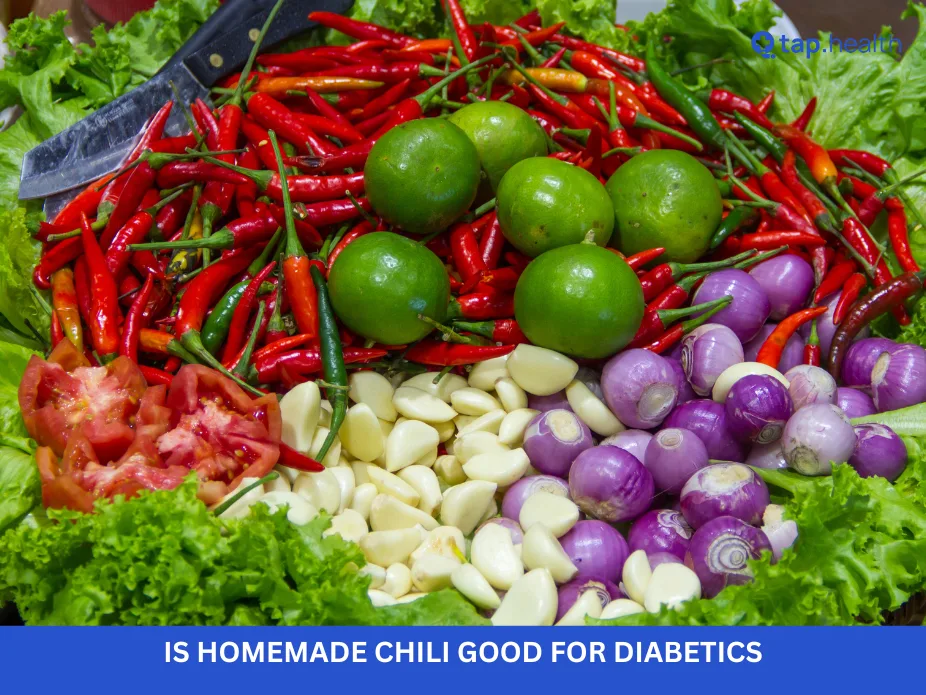Chili is a beloved comfort food enjoyed by many, especially during the colder months. It’s rich, flavorful, and filling. But if you’re diabetic, you might be wondering: Is homemade chili good for diabetics? Can it be enjoyed without spiking blood sugar levels? The short answer is, it depends.
In this article, we’ll explore whether homemade chili is a safe and nutritious option for people with diabetes, the potential health benefits, risks, and tips on how to make a healthier chili that won’t affect your blood sugar levels. Let’s dive in!
Understanding Diabetes and Nutrition
Before delving into the specifics of chili, it’s important to understand how diabetes affects the body, particularly when it comes to food choices.
What is Diabetes?
Diabetes is a condition that affects how your body uses glucose (sugar). In Type 1 diabetes, the body doesn’t produce insulin, while in Type 2 diabetes, the body becomes resistant to insulin, leading to high blood sugar levels.
The Role of Diet in Diabetes Management
For people with diabetes, managing blood sugar levels through diet is crucial. Eating the right foods can help maintain stable glucose levels, while poor food choices can lead to spikes or drops in blood sugar.
So, when considering homemade chili, the ingredients you use and portion control play a significant role in whether it can be part of a diabetic-friendly diet.
Is Homemade Chili Diabetic-Friendly?
Homemade chili can be a great option for diabetics when prepared with the right ingredients. The main concern is how the ingredients impact blood sugar levels.
What Are the Key Ingredients in Chili?
The typical ingredients in chili include:
- Beans: Rich in fiber and protein, beans are a great option for managing blood sugar. However, they are starchy, so portion control is important.
- Ground Meat: Commonly beef or turkey, which provides protein. Leaner options like turkey or chicken are better choices.
- Vegetables: Chili often contains tomatoes, onions, bell peppers, and spices like garlic. These vegetables are low in calories and can help manage blood sugar levels.
- Spices and Seasonings: Ingredients like chili powder, cumin, and paprika add flavor without adding sugar or carbs.
While these ingredients can be part of a healthy chili, certain factors may need to be adjusted for diabetics.
Benefits of Homemade Chili for Diabetics
Homemade chili, when made with the right ingredients, can offer several benefits for diabetics. Let’s take a closer look:
1. High in Protein and Fiber
Protein helps stabilize blood sugar by slowing down the absorption of carbohydrates, preventing rapid spikes. Beans and lean meats provide a good source of protein. Fiber, found abundantly in beans and vegetables, also helps regulate blood sugar by slowing digestion.
2. Low in Processed Ingredients
One of the benefits of making chili at home is that you can control the ingredients. Many store-bought chili products contain added sugars, preservatives, and unhealthy fats. By making your own chili, you can avoid these additives and ensure a healthier, cleaner recipe.
3. Packed with Nutrients
Homemade chili is full of vegetables that provide essential vitamins and minerals like vitamin C, potassium, and folate. These nutrients help support overall health and improve insulin sensitivity, which is important for managing diabetes.
Potential Risks of Homemade Chili for Diabetics
While homemade chili can be healthy, there are some risks to be aware of, especially when it comes to managing blood sugar levels.
1. Carbohydrates in Beans
Beans are a great source of fiber, but they also contain carbohydrates. For diabetics, consuming too many carbs in one meal can lead to a spike in blood sugar levels. It’s essential to manage portions and balance beans with other low-carb ingredients like vegetables and lean meats.
2. High-Sodium Content
Many chili recipes call for canned beans or processed meats, which can be high in sodium. Excess sodium can lead to high blood pressure, a common concern for people with diabetes. Opting for low-sodium canned beans and seasoning your chili with fresh spices can help reduce sodium intake.
3. Fat Content in Ground Meat
Some chili recipes use fatty cuts of meat like beef, which can increase the overall fat content of the dish. While fats are important in a balanced diet, excessive amounts of unhealthy fats can lead to weight gain and insulin resistance. Using lean meats, like ground turkey or chicken, is a better choice for diabetics.
How to Make Diabetes-Friendly Homemade Chili
Now that you understand the potential benefits and risks, let’s talk about how to make chili that is suitable for someone with diabetes. The goal is to make a low-carb, high-protein, and low-sodium version.
1. Choose Lean Proteins
Instead of using fatty cuts of beef, opt for lean proteins like ground turkey, chicken, or vegetarian options like tofu or tempeh. These proteins will provide the necessary nutrients without the excess fat.
2. Use Low-Sodium or Fresh Ingredients
To cut down on sodium, use fresh tomatoes, onions, and bell peppers instead of canned ones. If using canned beans, look for low-sodium or no-salt-added varieties.
3. Incorporate More Vegetables
Adding a variety of vegetables to your chili increases the fiber content and provides more vitamins and minerals. Consider adding zucchini, carrots, or spinach to boost the nutrition of your chili.
4. Control the Portion Sizes of Beans
Beans are great for managing blood sugar, but since they are starchy, portion control is important. Limit the amount of beans you add to your chili, and try combining them with non-starchy vegetables to balance the meal.
5. Avoid Added Sugars
Some chili recipes include added sugar or sweeteners to balance the acidity of tomatoes. For diabetics, this is a no-go. Avoid using sugar or opt for natural sweeteners like stevia if you need to reduce the acidity.
6. Experiment with Spices
Spices not only enhance the flavor but can also offer health benefits. Cayenne pepper and turmeric have anti-inflammatory properties, and garlic can help improve insulin sensitivity. Get creative with your spice mix!
Real-Life Scenario
Imagine a person with type 2 diabetes enjoying dinner. Instead of ordering fast food, they prepare homemade chili using kidney beans, ground turkey, tomatoes, and bell peppers. This version provides fiber, protein, and essential nutrients without raising blood sugar too quickly. By controlling the recipe at home, they avoid hidden sugars and excess sodium often found in canned or restaurant chili.
Expert Contribution
Health experts and dietitians highlight that high-fiber meals are beneficial for diabetics because they improve insulin sensitivity. Beans in chili are a great plant-based protein source with low glycemic index (GI), making them diabetic-friendly. Experts suggest replacing red meat with leaner meats or plant-based proteins to reduce saturated fat intake, which supports heart health—a major concern for people with diabetes.
Recommendations Grounded in Proven Research and Facts
- Use beans and vegetables: High fiber content helps regulate blood sugar.
- Choose lean protein: Turkey, chicken, or plant-based proteins are healthier than red meat.
- Limit added sugars: Some recipes include sugar; diabetics should skip it.
- Control salt: Excess sodium can increase blood pressure; use herbs and spices for flavor.
- Watch portion sizes: Even healthy chili can add calories if portions are too large.
- Pair wisely: Eat with whole grains like brown rice or quinoa instead of white bread or rice.
Frequently Asked Questions (FAQ) on Is Homemade Chili Good for Diabetics?
1. Can Diabetics Eat Chili Beans?
Yes, diabetics can eat chili beans, but it’s important to monitor portion sizes. Beans are a good source of fiber and protein, but they contain carbohydrates, so eating in moderation is key.
2. How Many Carbs Are in Chili for Diabetics?
The carbohydrate content of chili depends on the ingredients used. Beans, in particular, are high in carbs, but by controlling portion sizes and adding more vegetables, you can keep the carb count lower.
3. Is Ground Turkey or Chicken Better for Diabetics?
Both ground turkey and chicken are excellent choices for diabetics because they are leaner options compared to ground beef. They provide protein without the added saturated fats.
4. Can Homemade Chili Help Lower Blood Sugar?
While homemade chili alone isn’t a cure for diabetes, it can help stabilize blood sugar when made with healthy, whole-food ingredients. The fiber and protein in beans and lean meats can help regulate blood sugar levels.
5. Is It Better to Make Chili from Scratch or Buy Pre-made?
It’s always better to make chili from scratch because you can control the ingredients. Pre-made chili often contains added sugars, unhealthy fats, and high sodium content, all of which can negatively impact blood sugar levels.
Conclusion: Can Diabetics Enjoy Homemade Chili?
The answer is yes! Homemade chili can be a healthy, diabetic-friendly meal when made with the right ingredients and portion control. By choosing lean proteins, using fresh vegetables, and watching your carb intake, you can enjoy a flavorful bowl of chili that supports your blood sugar management.
Remember to balance your chili with other healthy meals and stay mindful of your portion sizes. With the right recipe, homemade chili can be a satisfying and nourishing part of your diabetes management plan.



